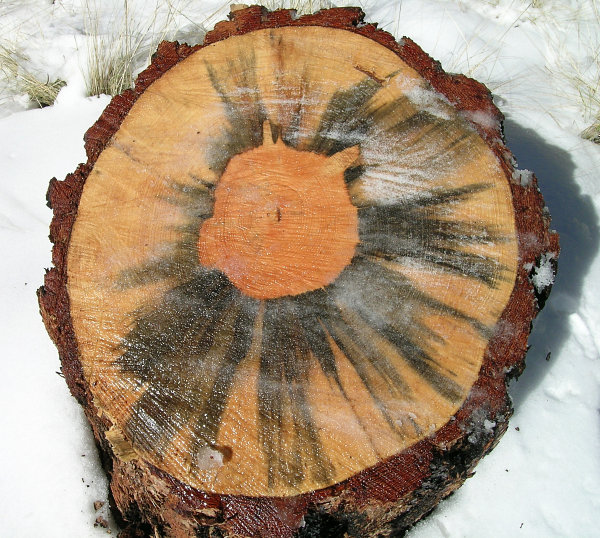Genome Sequence Of Fungus May Further Pine Beetle Research

By Sara Reardon
Collaborators at the B.C. Cancer Agency, University of British Columbia (UBC), and Simon Fraser University have assembled the first whole genome sequence of the blue-stain fungus Grosmannia clavigera, henchman of the mountain pine beetle (MPB) and named for the discoloration it inflicts on the wood of pine trees. A recent article published in Genome Biology describes the cutting-edge DNA sequencing technology SFU professor Steven Jones and his colleagues used to complete the sequence. Researchers will now be able to use the fungus' sequence to understand how its genes allow it to interact with the beetles and trees, possibly unveiling new ways to inhibit it.
This new tool comes none too soon. The lodgepole pine forests of the northwest are currently experiencing MPB infestations that Canadian Forest Service researcher Kathy Bleiker calls "unprecedented.” Over the past ten years, 13 to 14 million hectares of lodgepole pines in western Canada and part of the U.S. have been destroyed as a result of the epidemic. Bleiker attributes the outbreak to two factors: the past few winters have too warm to cull the MPB population, and increased wildfire prevention efforts have allowed the pine forests to age. The combination has created a "beetle smorgasbord” of old trees for the MPB to infest and eventually kill by cutting off the trees' nutrients.
The beetle's invasion is aided by the blue-stain fungus, which it carries in specialized mouthparts and is never found without. The fungus elicits the tree's defense mechanisms, which are often self-destructive, and weaken the tree against future MPB attacks. "It's a very highly evolved relationship,” says Bleiker, who was not involved in the research.
While the fungus needs the beetle as a vector to move from tree to tree, it can destroy a tree even in the absence of the MPB. Lead author Scott DiGuistini, a doctoral student at UBC, suggests it has been too often ignored as a pathogen. He is currently using its genomic sequence to identify genes that help the MPB invade trees, such as genes that detoxify the tree's defenses or provide a better nitrogen source for the MPB. Additionally, the genome allows researchers to look at whole populations of fungi and align their genomes to quickly identify the most virulent strains. "A lot of work has been done in the field of physiology; now we can bring this into the forest,” DiGuistini says.
 |  |
While the fungus' sequence is certainly an accomplishment in itself, the success of the new system used to compile it holds its own promise for Jones and the bioinformaticians on the team. The fungal genome is the first to be sequenced from scratch using the latest DNA sequencing technology, a system called Illumina. With the help of novel software, the researchers produced the sequence by combining Illumina sequence data with data from two older sequencing methods. The speed and low cost of this gestalt system is also promising for clinical research in human diseases such as cancer. "We're really, really excited about this,” says Jones. "We started this over a year ago with the blue-stain fungus, which has relevancy here, and now we'd like to sequence all kinds of organisms.” The group is currently applying their new technique to the MPB genome, which has a length ten times that of the fungus. "This technology is advancing by leaps and bounds; I think we can do just as good a job on the pine beetle as we did on the fungus.”
UBC professor and coauthor Joerg Bohlmann hopes that genetic information about the organisms involved will help policy makers and economic modeling experts head off MPB outbreaks before they devastate other areas as they have B.C.
"The outbreak here has reached the edge of its ecological niche,” says DiGuistini. "There just aren't enough trees left in B.C.” Chilling news, especially considering that the MPB has recently and unexpectedly managed to cross the Canadian Rockies into Alberta.
When the first outbreak occurred ten years ago, predictions failed to show how the disease would develop over both time and geography. Bohlmann believes the forecasting systems were inadequate because too little was known about the genetic make-up of the organisms involved; for instance, little attention was paid to the pathogenic fungi. Genomic data on the involved organisms may answer relevant questions such as why the fungus and beetle prefer a certain tree host and how they switch this preference, as the MPB seems to have done when it switched hosts from the lodgepole pines in BC to jack pines in Alberta.
Both DiGuistini and Bohlmann are cautious about predicting applications for the study. DiGuistini says that while it's a nice idea to imagine developing a treatment for trees, it is economically impossible, and furthermore, spraying forests with fungicides or insecticides would have detrimental ecological impacts. Instead, Bohlmann suggests that knowledge of the organisms' biology could be used to inform policy decisions, similar to the role epidemiology plays in public health decision-making. "If you have the beginning of an outbreak and accurate tools to predict what will happen as it grows, [loggers] could selectively harvest areas where the MPB is present or is likely to go next,” Bohlmann says.
Sara Reardon is a graduate student in molecular biology at the University of Washington.
Images
Top: Forest damage near Prince George, British Columbia. Photo: Dezene Huber, University of Northern British Columbia
www.thetriaproject.ca/index.php?article=rtpopgen
Bottom: Pine stump infested with G. clavigera. The blue stain decreases the value of the wood. Photo: U.S. Forest Service
www.fs.fed.us/r3/resources/health/fieldguide/sds/bluestain.shtml

|